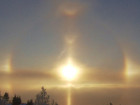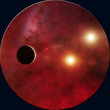|
Gravitational Waves!!! [and old Inflation Thread]
|
|
| Watsisname | Date: Sunday, 14.02.2016, 22:45 | Message # 31 |
 Galaxy Architect
Group: Global Moderators
 United States
United States
Messages: 2613
Status: Offline
| Quote midtskogen (  ) But instead we must say that if the theory we're confirming is right, a black hole merger, whose frequency is unknown, of this and this size, is the only thing that match the observation. This kind of fitting for the theory to be confirmed doesn't really do a very good job in excluding that the signal was from something that we haven't discovered yet.
The peak frequency of gravitational waves emitted by in-spiraling objects depends very strongly on how compact the objects are. Neutron stars can't reach this frequency because they collide first.
And again, the waves show the ringdown expected of the resulting black hole settling down into its final shape described by the Kerr metric.

|
| |
| |
| Watsisname | Date: Monday, 15.02.2016, 02:28 | Message # 32 |
 Galaxy Architect
Group: Global Moderators
 United States
United States
Messages: 2613
Status: Offline
| Within the final second of the merger, about 3 solar masses was radiated away as gravitational waves. That makes this event (briefly) more "luminous" than all of the stars in the observable universe put together!
If this gravitational wave energy was in the form of visible light, then it would appear as a flash of about -9th magnitude. This is many times brighter than Venus, and is comparable to the very brightest iridium flares! And it was about a billion light years away!
That is astounding.  It really puts into perspective how energetic black hole mergers are, as well as how weak the effect of gravitational waves are. It really puts into perspective how energetic black hole mergers are, as well as how weak the effect of gravitational waves are.

|
| |
| |
| midtskogen | Date: Monday, 15.02.2016, 07:45 | Message # 33 |
 Star Engineer
Group: Users
 Norway
Norway
Messages: 1674
Status: Offline
| Quote Watsisname (  ) The peak frequency of gravitational waves emitted by in-spiraling objects depends very strongly on how compact the objects are. Neutron stars can't reach this frequency because they collide first.
Right. A black hole merger is the only thing that we know of which matches the observation. The detection doesn't confirm that it was was a black hole merger, though. That would be to affirm the consequent.
Quote Watsisname (  ) Within the final second of the merger, about 3 solar masses was radiated away as gravitational waves. That makes this event (briefly) more "luminous" than all of the stars in the observable universe put together!
If this gravitational wave energy was in the form of visible light, then it would appear as a flash of about -9th magnitude. This is many times brighter than Venus, and is comparable to the very brightest iridium flares! And it was about a billion light years away!
It also puts into perspective what it could take to produce stable warp drives and wormholes...
If it were visible light, it would also have a serious effect on the hosting galaxy.
NIL DIFFICILE VOLENTI

|
| |
| |
| Watsisname | Date: Monday, 15.02.2016, 10:57 | Message # 34 |
 Galaxy Architect
Group: Global Moderators
 United States
United States
Messages: 2613
Status: Offline
| Quote midtskogen (  ) The detection doesn't confirm that it was was a black hole merger, though. That would be to affirm the consequent.
The search algorithms for merger events only look for signals with increasing frequency (chirps). Within this framework, there are an infinite variety of possible wave-forms that could be found that may or may not be consistent with general relativity, or even be consistent with general relativity yet require an inexplicable source. There is absolutely no guarantee that a detected signal should have a waveform that looks like a black hole merger, showing a frequency-amplitude-time evolution which matches GR's predictions.
We could have found a signal that looks like a black hole merger but with a different timescale for the ringdown, and we'd be going "WTF" and be even more excited because then some non-trivial part of our understanding of black holes and the field equations is wrong.
Quote midtskogen (  ) It also puts into perspective what it could take to produce stable warp drives and wormholes...
Well, it depends -- specifically on what kind of curvature you can get for a given amount of mass-energy, and that in turn depends on the metric, or what sort of mass-energy you have and how it is distributed. If you allow some really weird metric like Alcubierre's, with a lot of curvature in a small region of space, then maybe you don't need a lot of energy. The biggest problem with warp drives and wormholes is that we have no idea if those space-time geometries are even possible to generate, even if they are valid solutions to the field equations.
Quote midtskogen (  ) If it were visible light, it would also have a serious effect on the hosting galaxy.
Definitely! If this event were in the Andromeda galaxy and it was emitted as visible light, then it would (for less than a second anyway) appear in our sky as bright as the Sun!
Thankfully, the majority of the violence of black hole mergers isn't in light. 

|
| |
| |
| Watsisname | Date: Tuesday, 16.02.2016, 01:53 | Message # 35 |
 Galaxy Architect
Group: Global Moderators
 United States
United States
Messages: 2613
Status: Offline
| Some cool numerical relativity simulations of the event, showing the final phase of the in-spiral and the gravitational waves produced.
I like the first video for showing the timescale, which gives good idea of the rapidity of the merger and the enormous velocities involved. It also shows the acceleration vector field (the direction a particle placed there would be pulled, and how strongly, by the gravity), and the color shows the strength of the time dilation (red for extreme slowing of time.)
The second emphasizes the change in intensity of the gravitational waves. The amplitude becomes so large during the merger that the entire scale has to be shifted down to fit it all on the screen. It's like a giant tsunami. A storm in the sea of space-time. It also nicely shows the ringdown, as the final black hole rings analogously to a bell (but with a very fast damping period). In just a fraction of a second, it sheds off all irregularities and becomes indistinguishable from the classical rotating black hole.
These simulations were made by the Simulating eXtreme Spacetimes (SXS) group by solving the full Einstein field equations through numerical methods. This is an extremely difficult task, as they essentially form 10 coupled differential equations that must be solved simultaneously. Absolutely impossible for a human with pencil and paper -- you'd write out hundreds of pages for a single time-step of the system. The technology and techniques to be able to perform these simulations has developed only fairly recently.
For more, you can check out the team's website http://www.black-holes.org/
They have an excellent description of the basics behind this kind of work and how it brings together multiple fields of theoretical physics and observational astronomy. Plus a number of videos, and model waveforms of various G-wave producing phenomena converted into sound that you can hear. Very awesome stuff. 

|
| |
| |
| Watsisname | Date: Thursday, 12.05.2016, 10:27 | Message # 36 |
 Galaxy Architect
Group: Global Moderators
 United States
United States
Messages: 2613
Status: Offline
| Quote midtskogen (  ) Then there is seismic noise from the oceans (crashing waves), which will never fully away and form a constant background noise. They have a somewhat higher frequency (but still below 10 Hz). It's not clear in the paper how much of a problem this is and how they deal with it.
A classmate of mine recently visited the LIGO in Hanford (I'm very jealous)  and, in speaking with a technician, discovered the answer to this. It turns out that the instrument is sufficiently sensitive to detect the surf along the Pacific Coast (and elsewhere, but this is by far the most significant), and the way they deal with it is simply to not take data when the surf is too strong. That generally means during the late fall and winter, when the polar jet stream regularly brings low pressure systems into Washington and Oregon. But for the rest of the year, and especially in summer, we can get nice long stretches of sufficiently low noise to get good data. and, in speaking with a technician, discovered the answer to this. It turns out that the instrument is sufficiently sensitive to detect the surf along the Pacific Coast (and elsewhere, but this is by far the most significant), and the way they deal with it is simply to not take data when the surf is too strong. That generally means during the late fall and winter, when the polar jet stream regularly brings low pressure systems into Washington and Oregon. But for the rest of the year, and especially in summer, we can get nice long stretches of sufficiently low noise to get good data.
Another interesting tidbit was that lightning strikes can sometimes cause nearly coincident gravitational-wave-like signatures in both detectors, even from stupidly far away. One case originated from a particularly strong strike in Africa! Dealing with that requires yet another layer of environmental data collection, and fortunately they can determine that at the time of the announced GW event, terrestrial lightning cannot account for the strength of the signal (several orders of magnitude too small).

|
| |
| |
| Salvo | Date: Thursday, 12.05.2016, 11:14 | Message # 37 |
 Star Engineer
Group: Local Moderators
 Italy
Italy
Messages: 1400
Status: Offline
| This proves how convenient and extremely useful would be (in my opinion) having those kind of instrument on space.
Maybe a few of them in two orbits that are pretty far away.
I don't know if Jupiter or the Sun would make every detection more difficult, what do you know about this topic? Maybe I'm ignoring some issues that would make it not much more convenient than having them on Earth.
The universe is not required to be in perfect harmony with human ambition.
CPU: Intel Core i7 4770 GPU: ASUS Radeon R9 270 RAM: 8 GBs
(still don't know why everyone is doing this...)
|
| |
| |
| Mosfet | Date: Thursday, 12.05.2016, 13:57 | Message # 38 |
 World Builder
Group: Users
 Italy
Italy
Messages: 754
Status: Offline
| I guess the far side of the Moon could be an interesting place, some science-fiction writer actually imagined those detectors right there. Maybe orbiting on a Lagrangian point?
"Time is illusion. Lunchtime doubly so."
Douglas N. Adams
My mods
Asus x555ub: cpu i5-6200u - ram 4gb - gpu nvidia geforce 940m 2gb vram
|
| |
| |
| FastFourierTransform | Date: Thursday, 12.05.2016, 22:02 | Message # 39 |
 Pioneer
Group: Local Moderators
 Spain
Spain
Messages: 542
Status: Offline
| Quote Mosfet (  ) I guess the far side of the Moon could be an interesting place
That would be great but not for gravitational waves observatory. The moon is not transparent to those waves, neither the Earth so it dosen't matter if they are on the far side, near side or in the nucleus.
What probably would matter would be the moonquakes so the signal could get some noise because of that on the lunar surface.
The best place? Probably intergalactic space or some supervoid  but quite problematic to reach hahahaha. but quite problematic to reach hahahaha.
|
| |
| |
| Watsisname | Date: Friday, 13.05.2016, 04:33 | Message # 40 |
 Galaxy Architect
Group: Global Moderators
 United States
United States
Messages: 2613
Status: Offline
| Quote Salvo (  ) I don't know if Jupiter or the Sun would make every detection more difficult, what do you know about this topic? Maybe I'm ignoring some issues that would make it not much more convenient than having them on Earth.
A space-based interferometer would be sensitive to much lower frequency gravitational waves than observatories on Earth (due to the greater length scales probed by the laser beam), but this would still be much higher frequency than the drifts in the detectors caused by gravitational interaction with the planets. We should be able to model and account for those, as well. So I don't think it'd be a big problem.
For the Sun, I'm not really sure if or by how much it would have an effect, say by flares or changes in solar wind pressure at each detector. I'm guessing it would, but I'd have to look into it.
And yeah, the farside of the Moon would not be a good site. Gravitational waves, just like the gravitational field, cannot be shielded, and the Moon has its own seismic events. There's also a greater limitation in terms of the arm-lengths of the detectors you could build there. The Moon is smaller, so its surface has greater curvature. You can't get as long of a beam going as we can on Earth unless you can tunnel deep through the surface.
Overall, a space-based detector has the benefits of probing a different part of the gravitational wave spectrum (so we can see different kinds of sources, and discover merger events long before they actually merge), and remove the detector from the horrible vibrational noise that permeates the Earth. The downside is that it is way more expensive to put them in space, and then there are some different technical things to account for, like Doppler shift of the beams and time delay. But it's still the much better option. 
The ideal location for them would be in any kind of triplet of orbits that maintains equal path lengths between the spacecraft. Fortunately there's some cool orbital mechanics that allows us to do this. The wikipedia article for eLISA has some nice animations showing how their array would work.

|
| |
| |
| Salvo | Date: Friday, 13.05.2016, 07:40 | Message # 41 |
 Star Engineer
Group: Local Moderators
 Italy
Italy
Messages: 1400
Status: Offline
| Quote Watsisname (  ) the Moon has its own seismic events
Yeah, also since there's not water or soft terrain like on the Earth, I expect them to last for much more time, maybe even an hour... 
Quote Watsisname (  ) The wikipedia article for eLISA has some nice animations showing how their array would work.
That's definitely a nice animation! (Lagrange points are awesome)
The page itself it's very well written though.
The universe is not required to be in perfect harmony with human ambition.
CPU: Intel Core i7 4770 GPU: ASUS Radeon R9 270 RAM: 8 GBs
(still don't know why everyone is doing this...)
Edited by Salvo - Friday, 13.05.2016, 07:44 |
| |
| |
| anonymousgamer | Date: Thursday, 16.06.2016, 09:34 | Message # 42 |
 World Builder
Group: Global Moderators
 United States
United States
Messages: 1011
Status: Offline
| LIGO has detected graviational waves for a second time.
Desktop: FX-8350 4.0 GHz, 8 GB DDR3 RAM, EVGA GeForce GTX 1080 FTW 8 GB, 2 TB HDD, 24 inch 1920x1080 screen
Laptop: Core i5 480M 2.66 GHz (turbo 2.93), 8 GB DDR3 RAM, AMD Radeon HD 6550m 1 GB, 640 GB HDD, 17.3 inch 1600x900 screen
|
| |
| |
| Watsisname | Date: Friday, 17.06.2016, 02:03 | Message # 43 |
 Galaxy Architect
Group: Global Moderators
 United States
United States
Messages: 2613
Status: Offline
| Yeah, just saw that last night. It's great news. It proves gravitational wave astronomy is a real thing, with much out there to be studied and learned. :)
This signal was also much less strong than the first one announced, and had to be teased out of the data. The first detection was actually very surprising in just how strong it was -- they expected a similar kind of data analysis would be needed just to make it evident. But it was so strong as to be visible right out of the raw feed.

|
| |
| |
 ENG
ENG




 United States
United States 



 It really puts into perspective how energetic black hole mergers are, as well as how weak the effect of gravitational waves are.
It really puts into perspective how energetic black hole mergers are, as well as how weak the effect of gravitational waves are.
 Norway
Norway 


 Italy
Italy 

 Spain
Spain  but quite problematic to reach hahahaha.
but quite problematic to reach hahahaha.